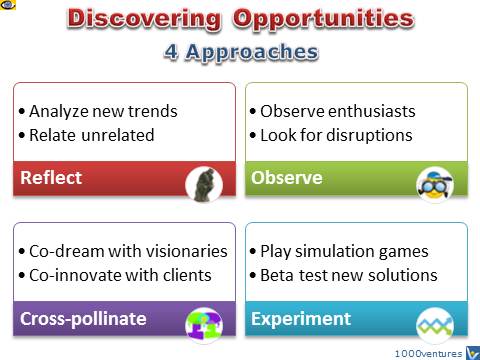To spot a great business opportunity, identify unmet market needs and evaluate the potential for sustainable growth. Consider the demand, competition, and market trends.
Identifying a lucrative business opportunity can be a game-changer for entrepreneurs. The first step involves recognizing gaps in the market that current solutions do not adequately address. This requires a keen understanding of industry dynamics and consumer behavior. Assessing the competition helps gauge the feasibility and profitability of the idea.
Market trends offer insights into future demands, enabling better decision-making. A thorough analysis ensures that the opportunity aligns with your strengths and resources. By focusing on these factors, you can increase the chances of success and create a sustainable business.

Credit: www.amazon.com
Identifying Market Needs
Understanding market needs is essential for finding great business opportunities. By identifying what the market demands, you can create products or services that truly resonate with your target audience. This involves analyzing emerging trends and recognizing customer pain points.
Emerging Trends
Keeping an eye on emerging trends helps you stay ahead of the curve. Look for new technologies, changing consumer behaviors, and shifts in the economy. These can indicate growing markets or untapped opportunities.
Use tools like Google Trends, social media analytics, and industry reports. These resources provide valuable insights into what is gaining traction.
| Source | What it Offers |
|---|---|
| Google Trends | Real-time data on search interest |
| Social Media Analytics | Insights on trending topics and hashtags |
| Industry Reports | Comprehensive market analysis |
Customer Pain Points
Identifying customer pain points can lead to innovative solutions. These are specific problems or frustrations that customers face. Addressing these issues can set your business apart.
Use surveys, customer reviews, and direct feedback to gather this information. Pay attention to common complaints and recurring issues.
- Conduct surveys to gather direct feedback
- Analyze customer reviews for common complaints
- Engage with customers through social media
By focusing on these pain points, you can develop products or services that provide real value.
Analyzing Competition
Analyzing competition is crucial to spotting a great business opportunity. This process helps you understand your market position. It also reveals potential gaps you can exploit. Below, we will focus on two essential aspects: Market Share and Competitive Advantage.
Market Share
Market share indicates how much of the market you control. Understanding your competitors’ market share can reveal opportunities. For example, if one company dominates, it may be tough to compete. Conversely, a fragmented market may offer more room for new entrants.
Here’s how to analyze market share:
- Identify major competitors.
- Research their revenue and customer base.
- Compare their market share with your potential share.
This information helps you gauge your entry point. It also highlights areas where you can compete effectively.
Competitive Advantage
Competitive advantage differentiates your business from others. It is what makes customers choose you over competitors. Understanding your competitors’ strengths and weaknesses is key.
Consider the following aspects:
| Aspect | Details |
|---|---|
| Product Quality | Is their product superior or inferior? |
| Pricing | Are they offering lower or higher prices? |
| Customer Service | Do they excel in customer support? |
Analyze these factors to find your own competitive advantage. Once identified, leverage it to attract customers and build loyalty.
Evaluating Financial Potential
Evaluating financial potential is crucial to spotting a great business opportunity. Understanding the numbers ensures that you make informed decisions. Let’s dive into key aspects: revenue streams and profit margins.
Revenue Streams
A business needs multiple revenue streams to thrive. Diversification reduces risk and increases stability. Here are some questions to consider:
- What are the primary sources of income?
- Is there potential for recurring revenue?
- Can the business tap into new markets?
Identifying robust revenue streams is essential for long-term success. Consider the following table for clarity:
| Revenue Stream | Description | Stability |
|---|---|---|
| Product Sales | Income from selling goods | High |
| Subscription Fees | Monthly or yearly charges | Very High |
| Service Charges | Fees for services provided | Medium |
Profit Margins
Profit margins indicate the financial health of a business. High margins lead to more profit and growth. Assessing profit margins involves:
- Calculating gross profit margin
- Understanding net profit margin
- Evaluating operating profit margin
Here’s a simple formula for calculating gross profit margin:
Gross Profit Margin = (Revenue - Cost of Goods Sold) / RevenueEnsure your profit margins are competitive within your industry. High margins mean better financial performance and sustainability.
Assessing Market Size
Assessing market size is crucial for spotting a great business opportunity. Understanding the potential market helps in making informed decisions. This section will cover two key aspects: Target Demographics and Market Saturation.
Target Demographics
Knowing your target demographics is essential. It helps in understanding who will buy your product.
Consider the following factors:
- Age
- Gender
- Income Level
- Location
For example, a product aimed at teenagers will have different marketing strategies. Income level affects purchasing power. Location plays a role in market size. Analyzing these factors helps in estimating the market size.
Market Saturation
Market saturation measures the extent of competition in the market. A saturated market has many competitors. This makes it harder to stand out.
Here are some ways to assess market saturation:
- Conduct competitor analysis
- Check market share distribution
- Look at customer reviews
Competitor analysis involves identifying key players. Market share distribution shows how much of the market is controlled by competitors. Customer reviews give insights into market needs.
Consider the table below to understand market saturation:
| Factor | Low Saturation | High Saturation |
|---|---|---|
| Number of Competitors | Few | Many |
| Market Share | Evenly Distributed | Dominated by Few |
| Customer Reviews | High Variety | Similar Feedback |
A low saturation market offers more opportunities. It is easier to capture a share of the market.
Leveraging Industry Expertise
Leveraging industry expertise is crucial for spotting great business opportunities. Industry experts have deep insights that can guide your decisions. Their experience helps you avoid common pitfalls and seize profitable ventures.
Networking
Networking opens doors to valuable business opportunities. It connects you with experienced professionals who share their knowledge. You can join industry-specific events and online forums. These platforms provide a wealth of information.
- Attend trade shows and conferences.
- Join professional associations.
- Engage in online industry groups.
Building relationships with industry veterans is essential. Their insights can lead you to untapped markets and innovative ideas.
Mentorship
A mentor guides you through the complexities of the business world. They offer advice based on years of experience. A good mentor helps you identify viable business opportunities. They provide feedback and help refine your ideas.
- Seek mentors within your industry.
- Schedule regular meetings for guidance.
- Act on their feedback and advice.
Mentorship is a powerful tool for growth. Experienced mentors can foresee challenges you might miss.
Leveraging industry expertise through networking and mentorship enhances your ability to spot business opportunities. Utilize these resources to stay ahead in your industry.

Credit: www.xyonix.com
Understanding Regulatory Environment
Spotting a great business opportunity often requires understanding the regulatory environment. Regulations can make or break a business venture. Knowing the legal landscape ensures you stay compliant and avoid penalties. This understanding helps in making informed decisions and aligning your business strategy effectively.
Compliance Requirements
Compliance requirements are rules businesses must follow. These rules vary by industry and location. Failing to comply can lead to fines and legal trouble.
To understand compliance, first identify the relevant authorities. This includes local, state, and federal agencies. Each may have different regulations for your business.
Here are some steps to follow:
- Research industry-specific regulations.
- Consult with legal experts.
- Stay updated on changes in laws.
Consider creating a compliance checklist. This helps ensure you meet all requirements consistently.
Legal Considerations
Legal considerations are crucial for any business. These include intellectual property rights, contracts, and employment laws.
Understand the laws that impact your business type. For instance, online businesses must know about data privacy laws. Retail businesses need to be aware of consumer protection laws.
Here are some key legal areas:
| Legal Area | Description |
|---|---|
| Intellectual Property | Protects your business ideas and inventions. |
| Contracts | Legally binding agreements with partners or clients. |
| Employment Laws | Regulations for hiring and managing employees. |
Consulting a legal expert can save you from future troubles. They help navigate complex laws and protect your business interests.
Utilizing Technology
In today’s fast-paced world, technology plays a crucial role in business success. Spotting a great business opportunity often involves leveraging the latest tech. Let’s explore how utilizing technology can help you find and seize these opportunities.
Digital Tools
Digital tools can significantly boost business efficiency and growth. These tools offer insights and streamline operations. Here are some essential digital tools to consider:
- CRM Software: Manage customer relationships effectively.
- Analytics Platforms: Gain insights from your data.
- Project Management Apps: Keep track of tasks and deadlines.
Investing in these tools can help you make informed decisions. They provide the data needed to spot trends and opportunities.
Automation
Automation can save time and reduce human error. It allows your business to focus on strategic tasks. Here are some areas where automation can help:
- Email Marketing: Automate your email campaigns for better engagement.
- Social Media Scheduling: Plan and schedule posts in advance.
- Customer Support: Use chatbots to handle common queries.
Automation tools can enhance productivity and scalability. They free up resources, allowing you to focus on growth opportunities.
By leveraging digital tools and automation, you can spot and seize great business opportunities effectively.
Conducting Swot Analysis
Conducting a SWOT Analysis is vital to spot a great business opportunity. This method helps identify the Strengths, Weaknesses, Opportunities, and Threats linked to your business. It offers a clear picture of the current situation. Let’s dive into each component.
Strengths And Weaknesses
First, focus on your company’s strengths. These are the internal factors that give you an edge. Think about your unique skills, resources, and capabilities.
- What do you do better than others?
- Do you have a strong brand?
- What are your key assets?
Next, identify your weaknesses. These are the internal factors holding you back. Recognize areas where you need improvement.
- Where do you lack expertise?
- Do you have resource constraints?
- What feedback have you received?
Opportunities And Threats
Now, look at opportunities. These are external factors you can exploit to your advantage. Opportunities might come from market trends, customer needs, or technological advances.
- Are there new market trends?
- What are customers asking for?
- Can technology improve your processes?
Lastly, identify threats. These are external challenges that could harm your business. Be proactive in recognizing and mitigating these threats.
- Who are your competitors?
- Are there regulatory changes?
- What are the economic risks?
Here is a simple table summarizing the SWOT Analysis:
| Strengths | Weaknesses |
|---|---|
| Strong brand | Lack of expertise |
| Unique skills | Resource constraints |
| Key assets | Negative feedback |
| Opportunities | Threats |
|---|---|
| Market trends | Competitors |
| Customer needs | Regulatory changes |
| Technological advances | Economic risks |

Credit: kotelnikov.biz
Frequently Asked Questions
How To Spot A Good Business Opportunity?
Spot a good business opportunity by identifying market gaps, analyzing customer needs, and assessing competition. Ensure profitability, scalability, and sustainability.
What Are The Five Qualities Of A Good Business Opportunity?
A good business opportunity has market demand, profitability, scalability, uniqueness, and a strong value proposition.
How Do You Evaluate A Good Business Opportunity?
Evaluate a good business opportunity by analyzing market demand, competition, profitability, scalability, and alignment with your expertise. Ensure strong customer need and sustainable growth potential. Assess financial viability and potential return on investment. Consider industry trends and legal requirements. Conduct thorough research and consult experts if needed.
What Are The 5 Stages Of Opportunity Recognition?
The 5 stages of opportunity recognition are: idea generation, opportunity identification, idea evaluation, development, and commercialization. Each stage involves critical thinking and analysis to transform ideas into viable business opportunities. Effective execution at each stage increases the chances of successful opportunity realization.
Conclusion
Recognizing a great business opportunity involves thorough research and keen observation. Trust your instincts and evaluate market needs. Stay adaptable and open to new ideas. Remember, success often comes from taking calculated risks. By following these steps, you’ll be better equipped to identify and seize promising opportunities in the business world.

Luke Mahomet has established herself as a prominent figure in the realm of tips and tricks expertise, showcasing a unique talent for distilling practical insights and solutions across various domains. With a diverse background and an innate curiosity for efficiency and effectiveness, Luke Mahomet has become a trusted source for valuable tips and tricks that span personal development, productivity, and life hacks. Her career is marked by a commitment to simplifying complexities and empowering individuals with actionable advice. Luke Mahomet’s ability to offer practical solutions to everyday challenges, coupled with a knack for uncovering hidden gems of wisdom, has earned her a dedicated following. As a tips and tricks expert, she continues to be a guiding force, helping others navigate the nuances of life and work with practical and inventive solutions that make a meaningful impact.


